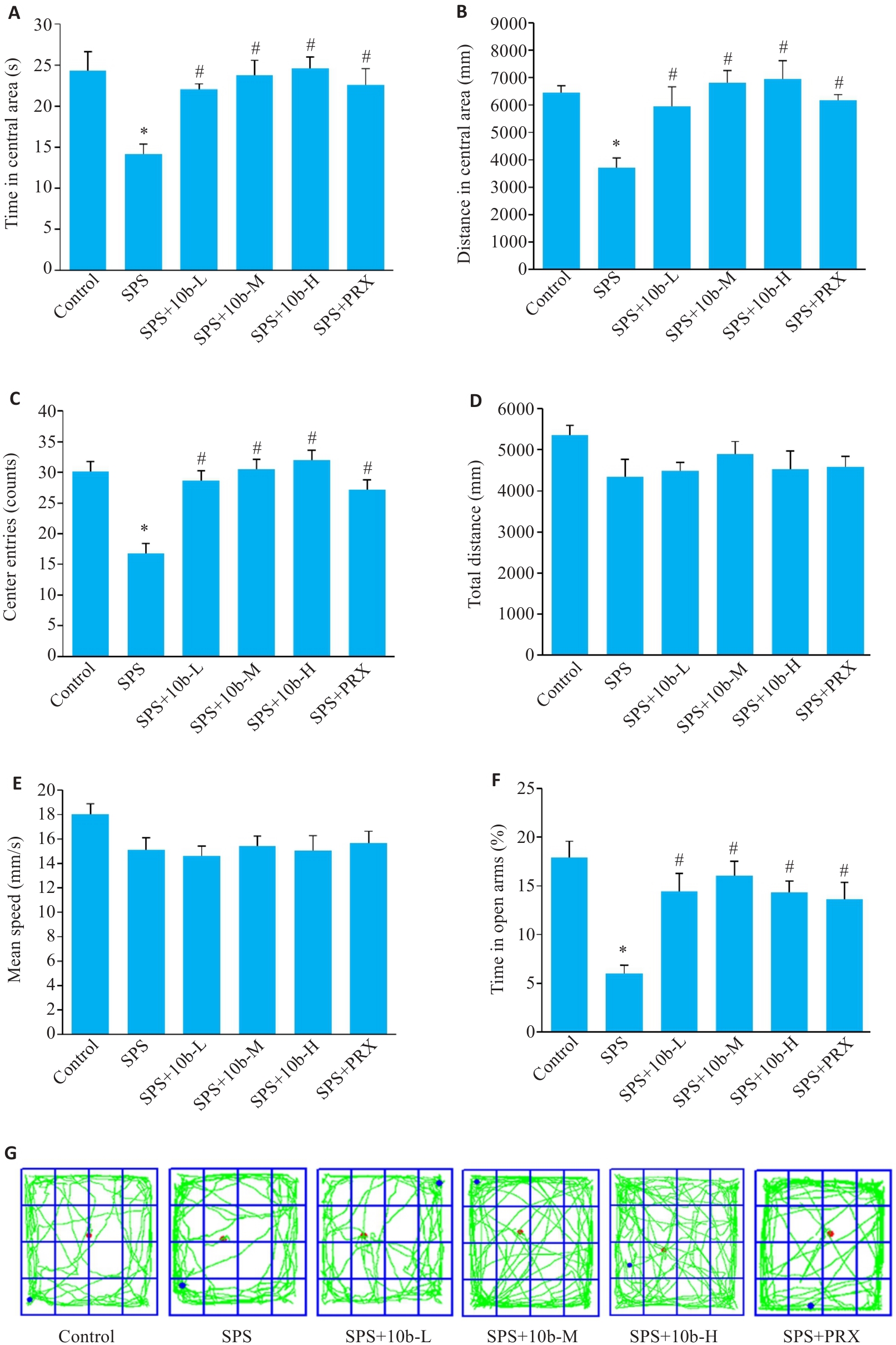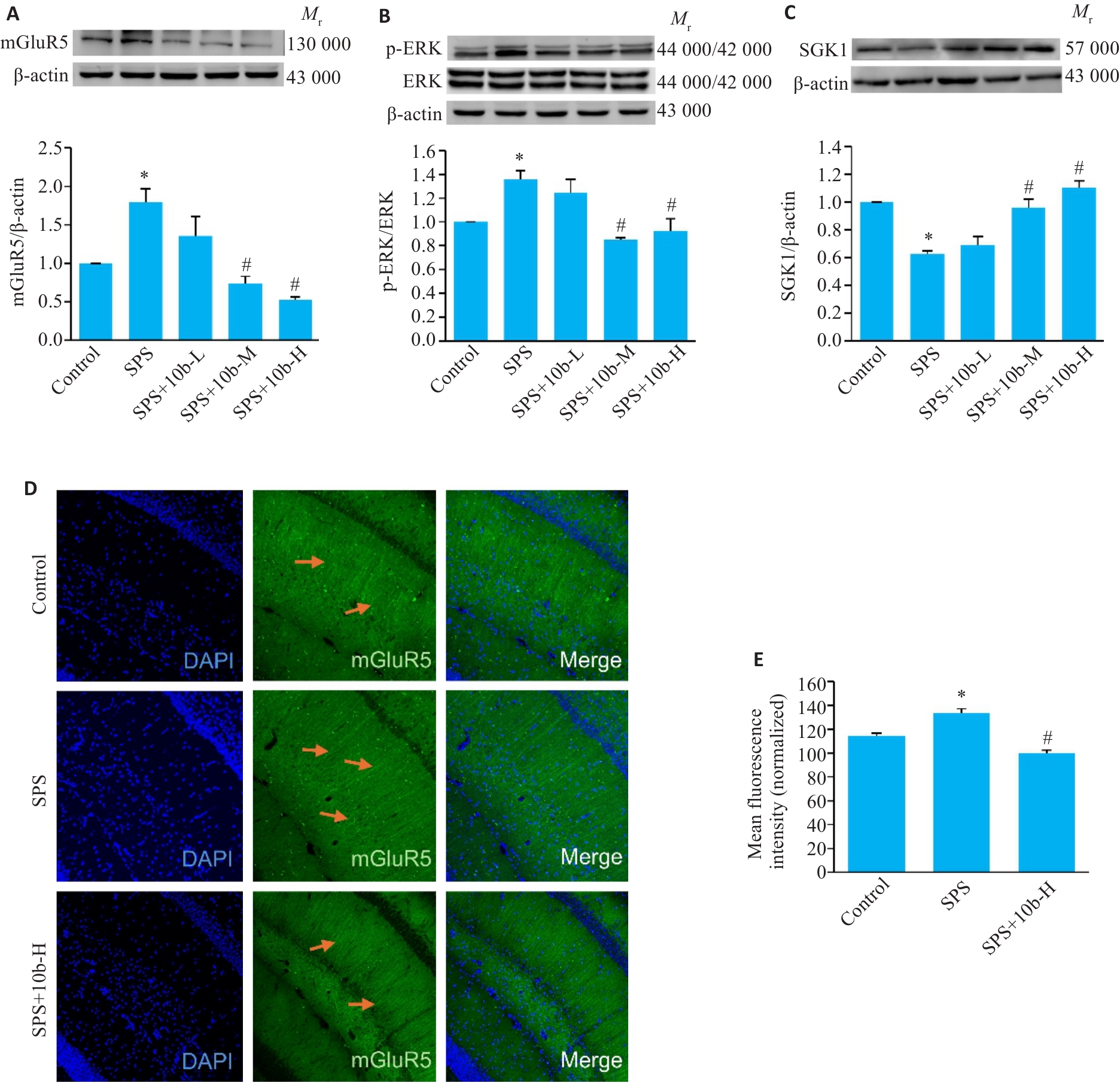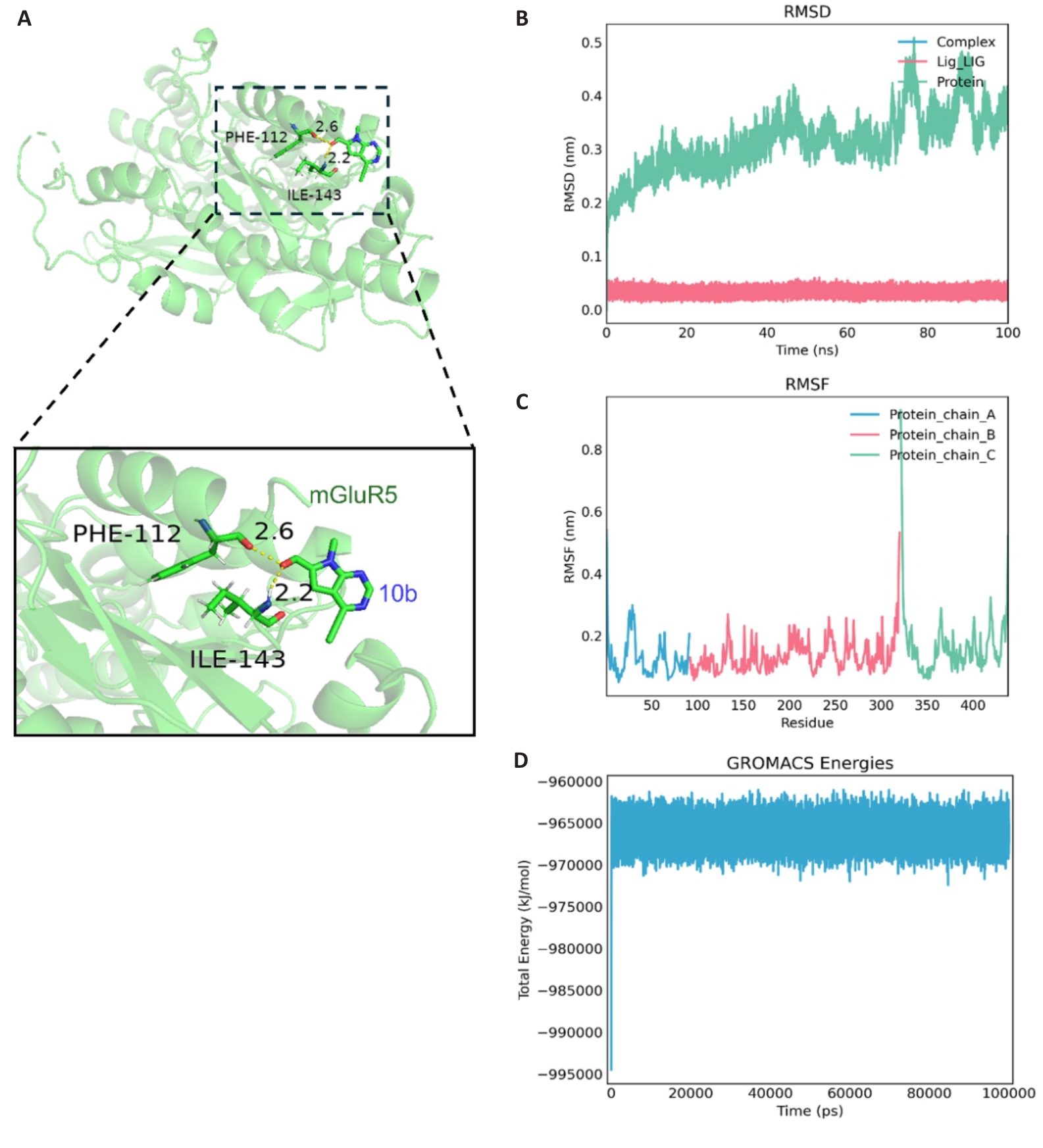Journal of Southern Medical University ›› 2025, Vol. 45 ›› Issue (4): 765-773.doi: 10.12122/j.issn.1673-4254.2025.04.12
Cunbao HE1( ), Shaojie YANG1,2(
), Shaojie YANG1,2( ), Guoqi ZHU1(
), Guoqi ZHU1( )
)
Received:2024-11-27
Online:2025-04-20
Published:2025-04-28
Contact:
Shaojie YANG, Guoqi ZHU
E-mail:2247022996@qq.com;1558589910@qq.com;Guoqizhu@gmail.com
Supported by:Cunbao HE, Shaojie YANG, Guoqi ZHU. 4‑(Arylethyl)‑pyrrolo[2,3-d] pyrimidine improves post-traumatic stress disorder in mice by inhibiting mGluR5-regulated ERK1/2-SGK1 signaling pathway[J]. Journal of Southern Medical University, 2025, 45(4): 765-773.
Add to citation manager EndNote|Ris|BibTeX
URL: https://www.j-smu.com/EN/10.12122/j.issn.1673-4254.2025.04.12

Fig.2 Compound 10b improves anxiety-like behaviors in mice with single prolonged stress (SPS). A-E: Statistics of time in central area, distance in central area, center entries, total distance and mean speed in open field test; F: Percentage of time in open arms in elevated plus maze test; G: Motion trajectory of open field test; *P<0.05 vs Control; #P<0.05 vs SPS.

Fig.3 Compound 10b improves abnormal fear memory in SPS mice. A : Freezing time in the re-exposure phase (○P<0.05: SPS+10b-L vs SPS; ▼P<0.05: SPS+10b-M vs SPS; ▲P<0.05: SPS+10b-H vs SPS; □P<0.05: SPS+PRX vs SPS). B: Freezing time in the extinction phase (*P<0.05 vs Control; #P<0.05 vs SPS).

Fig.4 Effects of compound 10b on expression levels of mGluR5, p-ERK and SGK1 proteins in mouse hippocampus. A: Western blotting and quantitative analysis of mGluR5 expression level. B: Western blotting and quantitative analysis of p-ERK expression levels. C: Western blotting and quantitative analysis of SGK1 expression; D, E: Immunofluorescence staining and fluorescence intensity of mGluR5 in hippocampal CA1 region. *P<0.05 vs Control; #P<0.05 vs SPS.

Fig.6 Molecular docking and molecular dynamics studies of compound 10b with mGluR5. A: Visualization of the molecular docking of compound 10b with mGluR5. B-D: RMSD, RMSF and energy analysis of molecular dynamics of compound 10b with mGluR5.
| 1 | Maercker A, Cloitre M, Bachem R, et al. Complex post-traumatic stress disorder[J]. Lancet, 2022, 400(10345): 60-72. |
| 2 | Valdivia G, Ardiles AO, Idowu A, et al. mGluR-dependent plasticity in rodent models of Alzheimer's disease[J]. Front Synaptic Neurosci, 2023, 15: 1123294. |
| 3 | Li X, Du ZJ, Xu JN, et al. mGluR5 in hippocampal CA1 pyramidal neurons mediates stress-induced anxiety-like behavior[J]. Neuropsychopharmacology, 2023, 48(8): 1164-74. |
| 4 | Kim J, Kang S, Choi TY, et al. Metabotropic glutamate receptor 5 in amygdala target neurons regulates susceptibility to chronic social stress [J]. Biolog Psychiatry, 2020, 92(2): 104-15. |
| 5 | Chen Y, Zhang Y, Chen Q, et al. Inhibition of mGluR5/PI3K-AKT pathway alleviates Alzheimer's disease-like pathology through the activation of autophagy in 5XFAD mice[J]. J Alzheimers Dis, 2023, 91(3): 1197-214. |
| 6 | Xuan SM, Su YW, Liang YM, et al. mGluR5 in amygdala modulates fear memory generalization[J]. Front Behav Neurosci, 2023, 17: 1072642. |
| 7 | Davis MT, Hillmer A, Holmes SE, et al. In vivo evidence for dysregulation of mGluR5 as a biomarker of suicidal ideation[J]. Proc Natl Acad Sci USA, 2019, 116(23): 11490-5. |
| 8 | Sun K, Xie R, Yi Z, et al. Amentoflavone impairs the reconsolidated fear memories through inhibition of ERK pathway [J]. Biochem Biophys Res Comm, 2020, 622: 8-14. |
| 9 | First M, Gil-Ad I, Taler M, et al. The effects of fluoxetine treatment in a chronic mild stress rat model on depression-related behavior, brain neurotrophins and ERK expression[J]. J Mol Neurosci, 2011, 45(2): 246-55. |
| 10 | Ma M, Quan HF, Chen SJ, et al. The anxiolytic effect of polysaccharides from stellariae Radix through monoamine neurotransmitters, HPA axis, and ECS/ERK/CREB/BDNF signaling pathway in stress-induced male rats[J]. Brain Res Bull, 2023, 203: 110768. |
| 11 | Thakur A, Choudhary D, Kumar B, et al. A review on post-traumatic stress disorder (PTSD): symptoms, therapies and recent case studies [J]. Curr Mol Pharmacol, 2020, 15(3): 502-16. |
| 12 | Miao XR, Chen QB, Wei K, et al. Posttraumatic stress disorder: from diagnosis to prevention[J]. Mil Med Res, 2018, 5(1): 32. |
| 13 | Park JC, Jeon YJ, Jang YS, et al. SGK1 knockdown in the medial prefrontal cortex reduces resistance to stress-induced memory impairment[J]. Eur Neuropsychopharmacol, 2021, 45: 29-34. |
| 14 | Yang YC, Ma YL, Liu WT, et al. Laminin-β1 impairs spatial learning through inhibition of ERK/MAPK and SGK1 signaling[J]. Neuropsychopharmacology, 2011, 36(12): 2571-86. |
| 15 | Stevenson RA, Hoffman JL, Maldonado-Devincci AM, et al. MGluR5 activity is required for the induction of ethanol behavioral sensitization and associated changes in ERK MAP kinase phosphorylation in the nucleus accumbens shell and lateral habenula[J]. Behav Brain Res, 2019, 367: 19-27. |
| 16 | Li Y, Shi W, Dai J, et al. Upregulated TNF-α and lactate following ERK-SGK1 activation in the spinal dorsal horn underlies chronic postsurgical pain [J]. Chin J Physiol, 2020, 66(3): 144-5. |
| 17 | Du YL, Gao F, Sun HW, et al. Novel substituted 4-(Arylethynyl)-Pyrrolo [2, 3-d] pyrimidines negative allosteric modulators (NAMs) of the metabotropic glutamate receptor subtype 5 (mGlu5) Treat depressive disorder in mice[J]. Eur J Med Chem, 2023, 261: 115855. |
| 18 | Xie P, Chen LX, Wang J, et al. Polysaccharides from Polygonatum cyrtonema Hua prevent post-traumatic stress disorder behaviors in mice: Mechanisms from the perspective of synaptic injury, oxidative stress, and neuroinflammation[J]. J Ethnopharmacol, 2024, 319: 117165. |
| 19 | Matrisciano F, Locci V, Dong E, et al. Altered expression and in vivo activity of mGlu5 variant a receptors in the striatum of BTBR mice: novel insights into the pathophysiology of adult idiopathic forms of autism spectrum disorders[J]. Curr Neuropharmacol, 2022, 20(12): 2354-68. |
| 20 | Cheng S, Xu J, Wang W, et al. Inhibition of mGluR5 alters BDNF/TrkB and GLT-1 expression in the prefrontal cortex and hippocampus and ameliorates PTSD-like behavior in rats [J]. Psychopharmacology, 2020, 240(4): 837-51. |
| 21 | Fuxe K, Borroto-Escuela DO. Basimglurant for treatment of major depressive disorder: a novel negative allosteric modulator of metabotropic glutamate receptor 5[J]. Expert Opin Investig Drugs, 2015, 24(9): 1247-60. |
| 22 | Arsova A, Møller TC, Vedel L, et al. Detailed in vitro pharmacological characterization of clinically tested negative allosteric modulators of the metabotropic glutamate receptor 5[J]. Mol Pharmacol, 2020, 98(1): 49-60. |
| 23 | Witkin JM, Pandey KP, Smith JL. Clinical investigations of compounds targeting metabotropic glutamate receptors[J]. Pharmacol Biochem Behav, 2022, 219: 173446. |
| 24 | Cavallone LF, Montana MC, Frey K, et al. The metabotropic glutamate receptor 5 negative allosteric modulator fenobam: pharmacokinetics, side effects, and analgesic effects in healthy human subjects[J]. Pain, 2020, 161(1): 135-46. |
| 25 | Luo L, Yang L, Zhang K, et al. Caveolin-1-mediated cholesterol accumulation contributes to exaggerated mGluR-dependent long-term depression and impaired cognition inFmr1 knockout mice[J]. Mol Neurobiol, 2023, 60(6): 3379-95. |
| 26 | Hakon J, Quattromani MJ, Sjölund C, et al. Inhibiting metabotropic glutamate receptor 5 after stroke restores brain function and connectivity[J]. Brain, 2024, 147(1): 186-200. |
| 27 | Jin DZ, Chen H, Zhou MH, et al. mGluR5 from primary sensory neurons promotes opioid-induced hyperalgesia and tolerance by interacting with and potentiating synaptic NMDA receptors[J]. J Neurosci, 2023, 43(31): 5593-607. |
| 28 | Lutzu S, Alviña K, Puente N, et al. Target cell-specific plasticity rules of NMDA receptor-mediated synaptic transmission in the hippocampus[J]. Front Cell Neurosci, 2023, 17: 1068472. |
| 29 | Zhang XY, Kim J, Tonegawa S. Amygdala reward neurons form and store fear extinction memory[J]. Neuron, 2020, 105(6): 1077-93. e7. |
| 30 | Blount HL, Dee J, Wu L, et al. Stress resilience-associated behaviors following predator scent stress are accompanied by upregulated nucleus accumbens mGlu5 transcription in female Sprague Dawley rats[J]. Behav Brain Res, 2023, 436: 114090. |
| 31 | Liu YW, Zhao L, Zhou M, et al. Transplantation with mGluR5 deficiency bone marrow displays antidepressant-like effect in C57BL/6J mice[J]. Brain Behav Immun, 2019, 79: 114-24. |
| 32 | Sanjay, Sood R, Jaiswal V, et al. Nobiletin regulates intracellular Ca2+ levels via IP3R and ameliorates neuroinflammation in Aβ42-induced astrocytes[J]. Redox Biol, 2024, 73: 103197. |
| 33 | Kim JM, Yang YS, Hong J, et al. Biphasic regulation of osteoblast development via the ERK MAPK-mTOR pathway [J]. eLife, 2020, 11: 203-12. |
| [1] | Ping YUAN, Xiuli HU, Guojia QI, Xiu DAI, Xiangyuan CHU, Weihang CHEN, Xiuquan SHI. Poor sleep quality contributes to occurrence of posttraumatic stress disorder in trauma patients [J]. Journal of Southern Medical University, 2024, 44(6): 1166-1172. |
| [2] | LI Yanxiang, GUO Yongxin, CAO Fuyang, GUO Shuting, XUE Dinghao, ZHOU Zhikang, HAO Xinyu, TONG Li, FU Qiang. Inhibition of glutamatergic neurons in the dorsomedial periaqueductal gray alleviates excessive defensive behaviors of mice with post-traumatic stress disorder [J]. Journal of Southern Medical University, 2024, 44(3): 420-427. |
| [3] |
.
Role of collagen triple helix repeat containing 1 in proliferation, migration, and invasion of human colorectal cancer cells [J]. Journal of Southern Medical University, 2015, 35(05): 767-. |
| Viewed | ||||||
|
Full text |
|
|||||
|
Abstract |
|
|||||